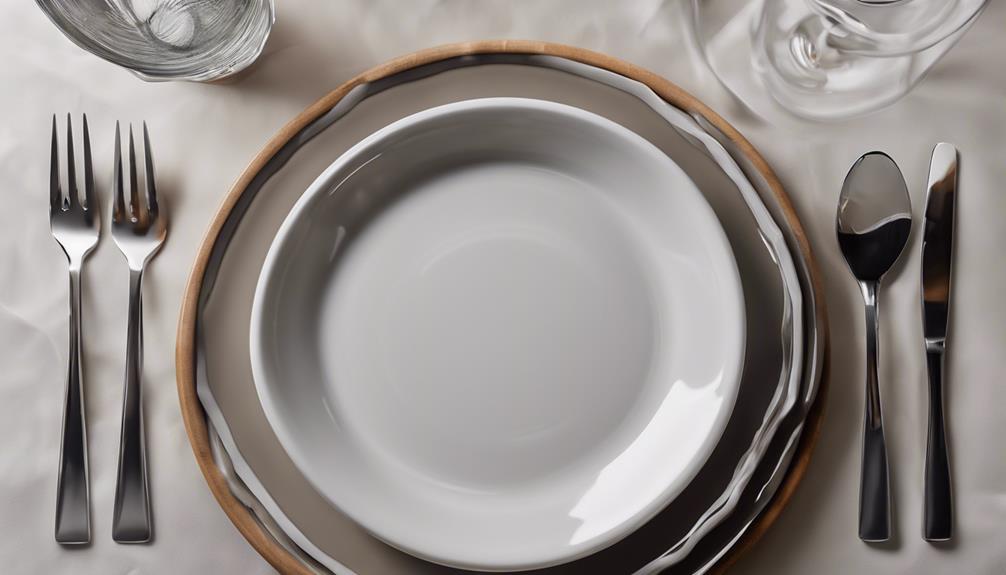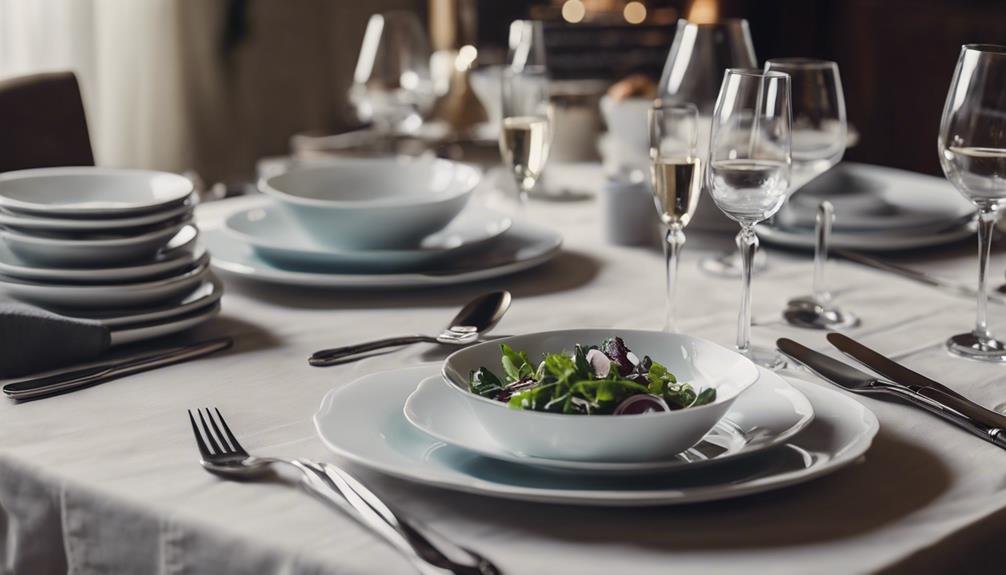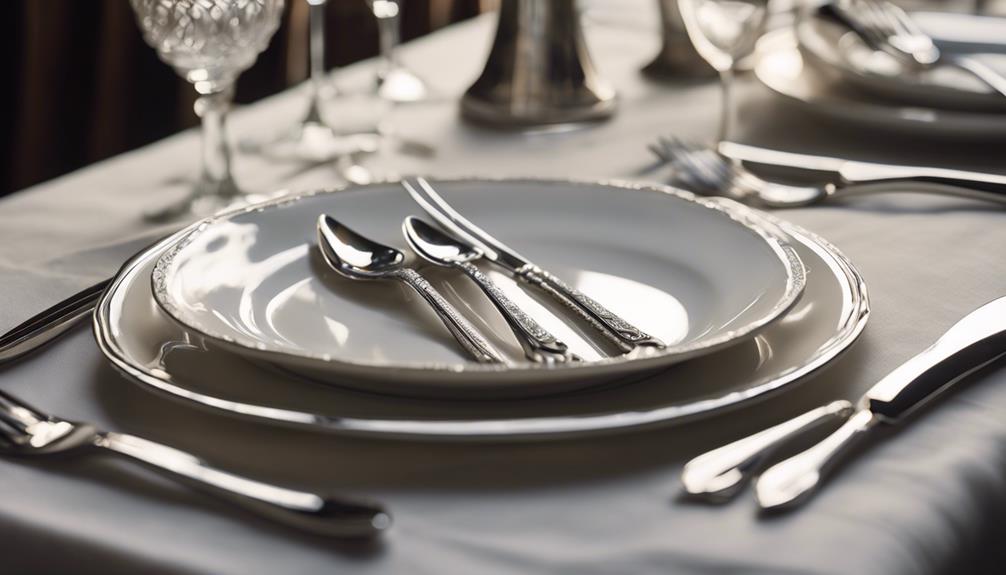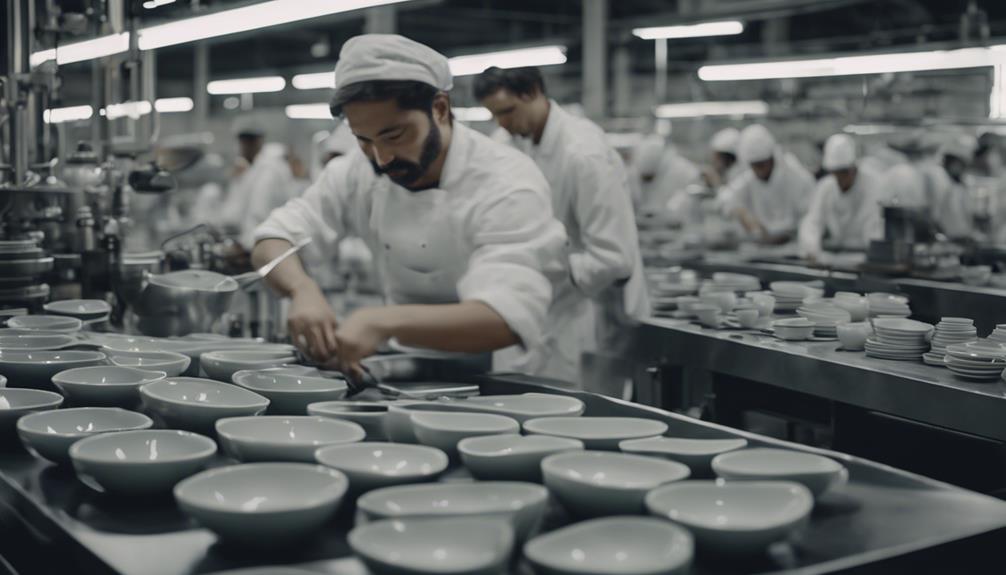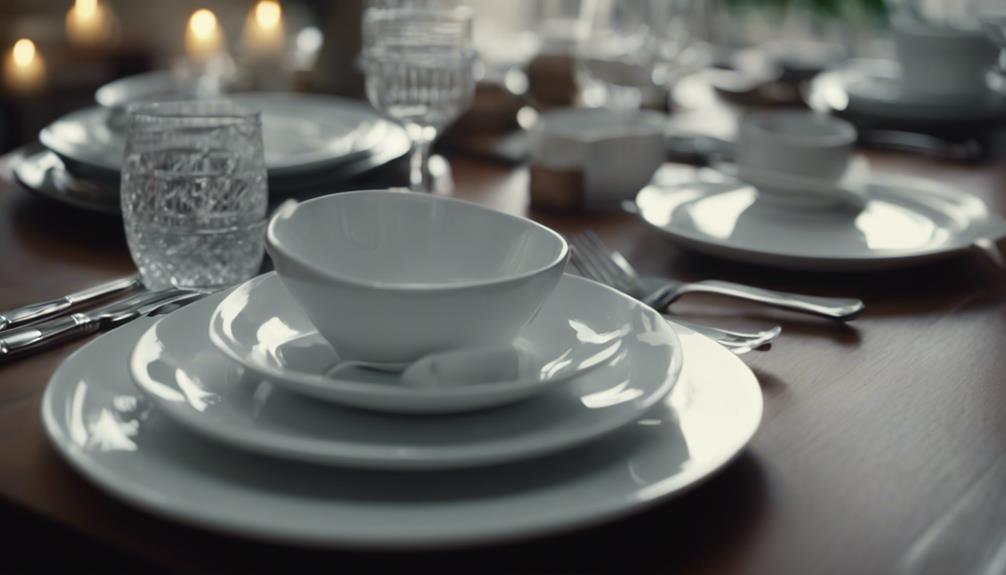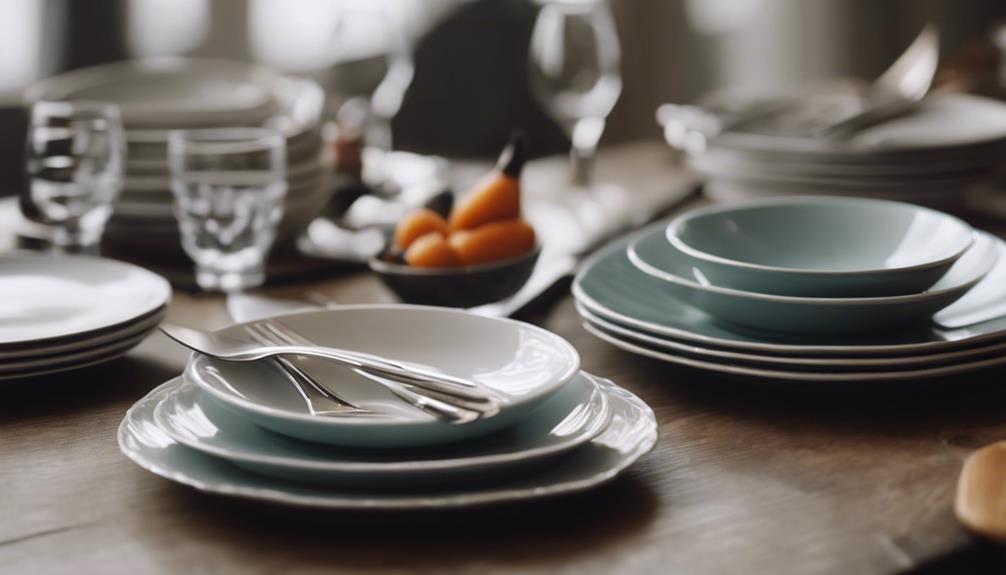When it comes to tableware, there are four primary categories. Dinnerware includes plates and bowls in different shapes and colors. Glassware includes stemware for elegance and tumblers for versatility. Flatware includes knives, spoons, and forks for various dining needs. Serving pieces like salad bowls and platters improve food presentation. Each category plays an important role in enhancing your dining experience.
Key Takeaways
- Dinnerware includes plates, bowls, and serving pieces.
- Glassware consists of stemware, tumblers, mugs, cups, and glasses.
- Flatware comprises knives, spoons, and forks for dining needs.
- Serving pieces like salad bowls, platters, soup pots, and dessert bowls enhance food presentation.
- Types of tableware: chinaware, crockery, and glassware for varied dining experiences.
Dinnerware

When setting the table, dinnerware plays a significant role in enhancing the dining experience. Dinnerware includes plates, bowls, and specialized serving pieces for individual portions during a meal. The types of dinnerware vary, with options like chinaware, crockery, and glassware, each offering a unique touch to your table settings.
Plates are an essential part of dinnerware, providing the base for serving meals. They come in different shapes, colors, and sizes to suit various dishes and aesthetics. Bowls, on the other hand, are perfect for serving soups, salads, or desserts, adding depth to your table setting.
Chinaware is known for its delicate and elegant designs, ideal for formal dinners or special occasions. Crockery, which includes sturdier options like stoneware or earthenware, is great for everyday use. Glassware adds a touch of sophistication, perfect for serving beverages during meals. Choosing the right dinnerware can elevate your dining experience and create a cohesive and visually appealing table setting.
Glassware
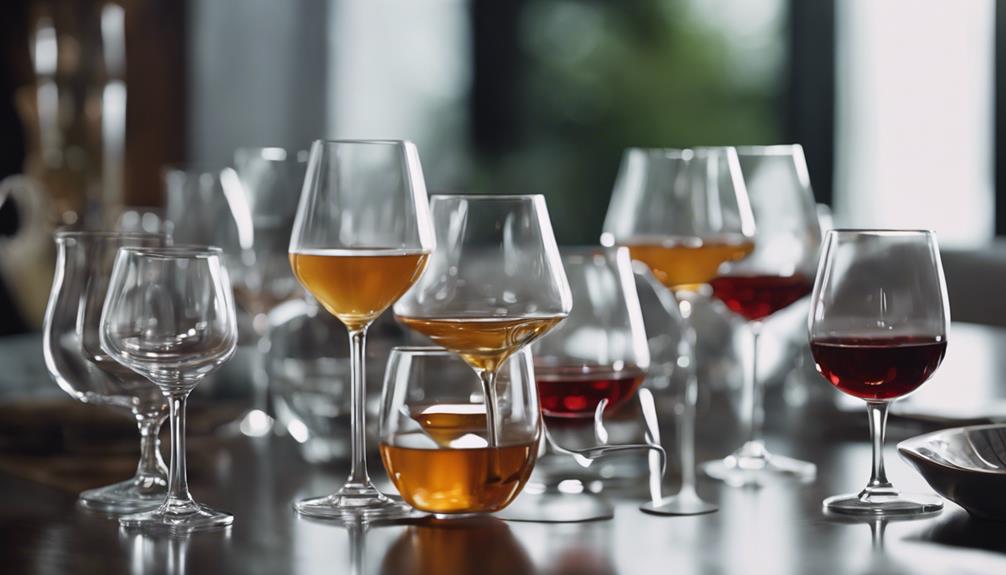
Glassware, an integral part of tableware, encompasses various types of stemware, tumblers, mugs, cups, and glasses, each serving a specific purpose in enhancing your dining experience.
Stemware like wine glasses, brandy glasses, and champagne flutes are elegant choices for serving different types of beverages, adding a touch of sophistication to your table setting.
Tumblers, including shot glasses, whiskey tumblers, and tall glasses, are versatile options ideal for various drinks from shots to cocktails.
Mugs, cups, and glasses offer a wide range of shapes and sizes within the glassware category, suitable for serving hot or cold beverages depending on your preference.
Selecting the right glassware based on the occasion and the type of cuisine being served can greatly enhance the overall dining experience, as glassware plays an important role in complementing the presentation and enjoyment of your favorite drinks.
Flatware
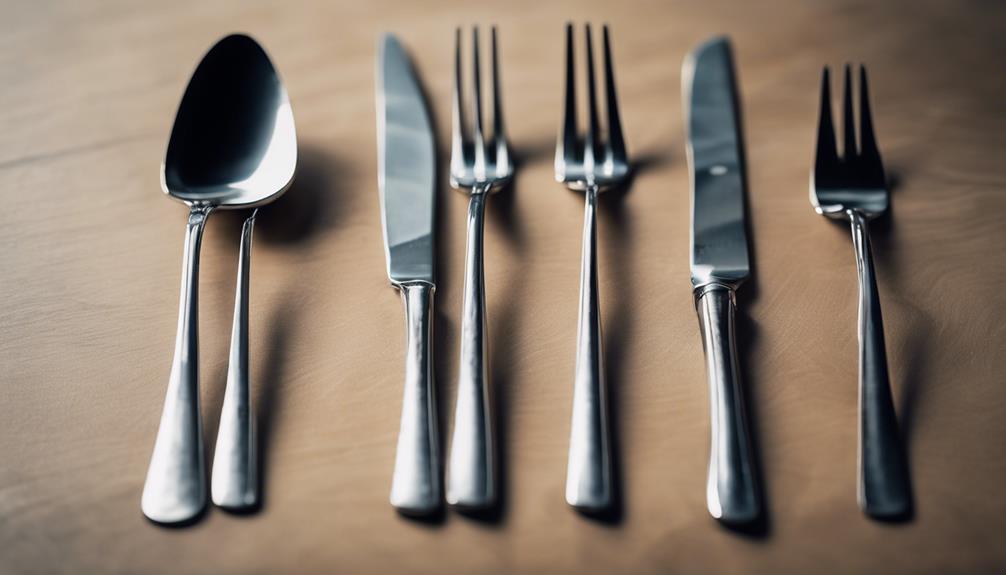
Flatware, comprising knives, spoons, and forks of various sizes and shapes, is an indispensable element of table settings for your dining needs.
Knives in flatware come in different types such as steak knives, dessert knives, and fish knives, each serving a specific purpose during meals. Spoons are another essential part of flatware, with options like soup spoons, dessert spoons, and tablespoons available for various dishes. Forks complete the trio, ranging from dinner forks to seafood forks, catering to different dining requirements.
Whether you're enjoying a juicy steak or indulging in a delectable dessert, having the right flatware enhances your dining experience. Setting the table with the appropriate knives, spoons, and forks ensures that you're well-equipped to savor every bite with ease and sophistication.
Serving Pieces
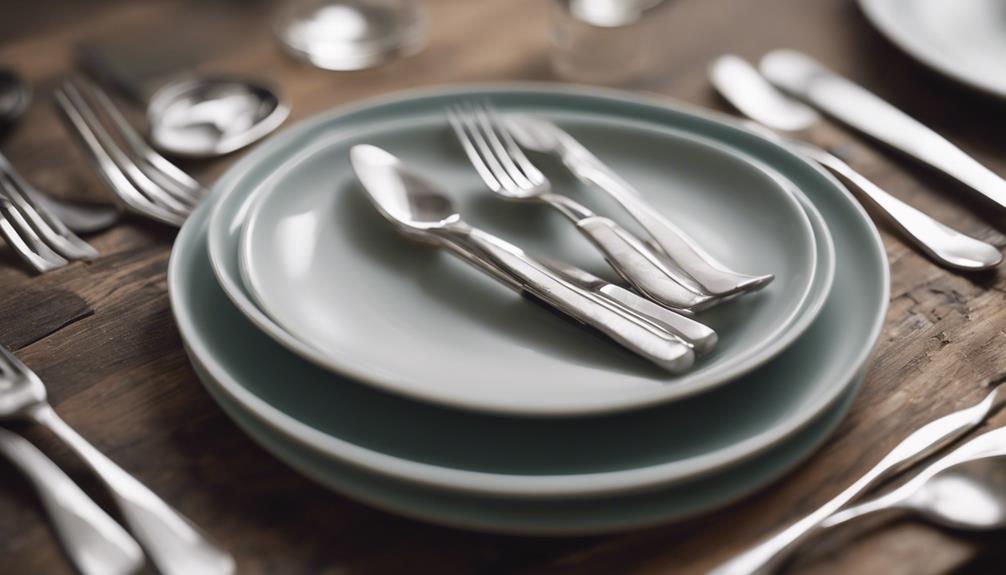
Serving pieces play a crucial role in enhancing the presentation and serving of food during meals. Here are four essential serving pieces you should consider for your table:
- Salad Bowls: Perfect for serving fresh salads to your family and friends, these bowls come in various sizes to accommodate different portions.
- Platters: Ideal for showcasing main dishes or appetizers, platters add a touch of elegance to your table setting when hosting gatherings.
- Soup Pots: Whether you're serving a hearty stew or a delicate soup, having the right soup pots can make it easier to serve and enjoy hot soups with your loved ones.
- Dessert Bowls: End your meals on a sweet note with dessert bowls that are designed to hold delectable treats like ice cream, fruit salads, or puddings, adding a delightful finish to your dining experience.
Investing in quality chinaware, cutlery, and glassware to complement your serving pieces can elevate your table setting and create memorable dining moments with family and friends.
Frequently Asked Questions
How Are Tableware Classified?
Tableware is classified into four main categories: serveware, dinnerware, flatware or silverware, and drinkware or glassware. Serveware includes items for serving food, like bowls and platters. Dinnerware consists of plates and bowls for eating. Flatware includes spoons, forks, and knives for dining. Drinkware encompasses glasses and cups for drinking.
These classifications help organize and enhance your dining experience. Each type serves a specific purpose at the table, making mealtime more convenient and enjoyable.
What Are the Basic Tablewares?
When setting the table, you'll need serveware, dinnerware, flatware or silverware, and drinkware or glassware.
Serveware includes bowls and platters for serving.
Dinnerware consists of plates and bowls for dining.
Flatware or silverware covers your cutlery needs.
Drinkware or glassware provides the cups and glasses for beverages.
Each type plays an essential role in creating a complete table setting for your meals.
What Is the Difference Between Tableware and Flatware?
When differentiating between tableware and flatware, remember that tableware encompasses serveware, dinnerware, and drinkware, while flatware specifically refers to cutlery like spoons, forks, and knives.
Tableware serves a broader purpose of both serving and eating, including items like plates, bowls, and glasses. In contrast, flatware focuses solely on the utensils used during meals.
Understanding this distinction helps in setting a complete dining table for any occasion.
What Is the Difference Between Tableware and Dinnerware?
When comparing tableware and dinnerware, the key difference lies in their functions. Tableware encompasses serveware, dinnerware, flatware, and drinkware, serving various purposes in dining settings.
Dinnerware specifically refers to items used for individual meal portions. Understanding this distinction helps you choose the right tableware for different dining occasions, ensuring your table is set appropriately.
This knowledge enhances your dining experience by matching the tableware to the meal service requirements.
Conclusion
To sum up, tableware is like a symphony orchestra, each piece playing a unique role in creating a harmonious dining experience.
From the elegant dinnerware setting the stage to the practical flatware and serving pieces conducting the meal, every element works together seamlessly.
Just like a well-coordinated performance, the right tableware enhances the dining experience and adds a touch of sophistication to any meal.
